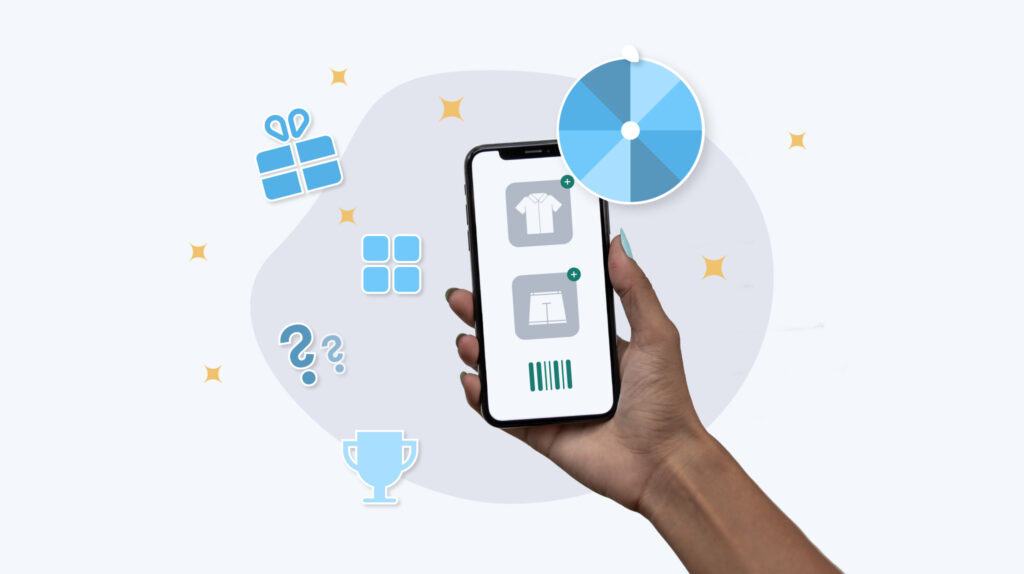Retail is a highly competitive industry, and it is expanding into ecommerce. This is because brick-and-mortar retailers seek more ways to reach customers and increase revenue.
9 of the top 10 ecommerce websites are run by retailers operating brick-and-mortar stores, according to the National Retail Federation (NRF).
With this accelerated expansion of the retail landscape, new retail practices are needed to keep pace. Besides traditional marketing, such as promotional materials, special deals, and window display communication, retail programs are looking toward personalized pricing strategies and digitized experiences for future campaigns.
We will look at 15 retail strategies and the key factors that drive these new retail efforts.
In this post, we focus on:
- What a retail strategy is
- The role gamification can play in retail
- Effective retail strategies for increasing revenue
- Implementing retail strategies at your store
Understanding Retail Strategies
A well-crafted retail strategy can significantly impact your store’s performance and help it establish a competitive edge in the marketplace.
Retail strategies are the tactical approaches retailers use to supply consumer demand and influence purchasing behavior. They encompass pricing, accessible product marketing, and strategic practices around product selection.
Setting strategies in place leverages your store’s potential to attract customers, increase footfall, and boost sales.
More importantly, an effective strategy is instrumental in directing consumer choices, guiding them toward products, and fostering brand loyalty. By analyzing consumer demand and the latest industry trends, retailers can identify potential opportunities for growth and adjust their strategies accordingly.
This could also mean expanding to new locations, introducing new products, or partnering with other companies to offer more options.
Investing your time and resources into developing effective strategies significantly impacts your bottom line.
Using Gamification In Retail Strategies
Gamification, the application of game elements such as competition, rewards, and points systems in non-game contexts, is gaining popularity in various industries. This is especially true in the retail industry.
By using gamification, retailers can create a more engaging and immersive shopping experience for customers, ultimately driving foot traffic and boosting sales.
“I’m a big proponent of gamification. I believe human psychology is hardwired to be encouraged by gamification. Commercial leaders must recognize that although their clients represent a business, humans are the decision-makers.” – Nick Bricker, Director of Partnerships and Sales at Designity
Gamification can be used in various ways in retail, from interactive point-of-sale displays and in-store competitions to loyalty programs and personalized rewards systems. Discover 15 strategies you can implement at your store today in the next section of this post.
15 Effective Retail Strategies For Your Store
- In-Store Events
- Loyalty Programs
- Personalized Marketing
- Omnichannel Retailing
- Social Media Integration
- Retailtainment
- Mobile Integration
- Targeted Promotions
- Product Demonstrations
- Employee Training
- Store Layout And Design
- Local SEO
- Community Engagement
- Pop-Up Shops
- In-Store Technology
Strategy 1: In-Store Events
As an experiential retail strategy, in-store events involve conducting events and activities within a retail store’s space to engage potential and current customers.
In-Store Events May Include:
- Product demonstrations
- Workshops
- Interactive displays
- Local artist showcases
- Community enrichment events
- Competitions
Implementing in-store events can drive foot traffic to the store, increase customer engagement and loyalty, and provide a unique experience that customers cannot get online.
Hosting events can also provide opportunities to gather customer feedback and insights, provide product knowledge, and create brand awareness.
Gamification can be effective in driving participation and engagement in in-store events. You can create competitions, scavenger hunts, or mini-games that encourage customers to participate in the event.
Through a gamified approach, you can incentivize customers to purchase products or share the event on social media to promote word-of-mouth.
How To Run An In-Store Event:
- Plan events around seasons or holidays to provide a timely experience to customers.
- Promote events on social media to reach a larger audience and encourage participation.
- Use gamification to increase participation and incentivize purchases.
- Gather customer feedback and insights to improve the events and overall customer experience.
- Collaborate with other local businesses or artists to create a unique and interesting event.
Strategy 2: Loyalty Programs
Customer loyalty programs are a type of retail strategy that incentivizes customers to continue shopping at a store by providing rewards and exclusive benefits. These programs can take many forms, such as points-based systems, membership-only deals, or personalized discounts.
Besides increasing customer retention and loyalty, loyalty programs can drive sales and improve customer satisfaction. This strategy enables you to create a sense of exclusivity and make customers feel appreciated and valued.
You can employ gamification to promote and enhance your loyalty programs. Create challenges, quests, or badges to encourage customer engagement with the program. Customers are further incentivized with rewards and healthy competition against other customers.
Depending on a customer’s purchase history or loyalty tenure, personalized recommendations or discounts can also be tailored.
Real-World Example: SPAR Friends
SPAR is the leading voluntary food retail chain in the world. It recently launched its SPAR Friends loyalty program, giving frequent customers access to special promotions and points-based rewards.
The loyalty system is fully digitized as a mobile app that customers can download and access anytime. It encourages SPAR’s customers to make more purchases in grocery stores by taking advantage of tailored discount coupons and product vouchers.

How To Run A Loyalty Program:
- Tailor loyalty programs to fit the specific needs and preferences of the target customer base.
- Use personalized recommendations and discounts to provide added value to loyal customers.
- Consider gamification elements such as points, leaderboards, and time-limited promotions to incentivize customer engagement and competition.
- Regularly review and adjust the loyalty program to optimize its effectiveness.
Strategy 3: Personalized Marketing
Using consumer data to tailor marketing efforts and offers to individual customers has become essential for every business. You can create more relevant and targeted marketing campaigns by leveraging customer behavior, preferences, and purchase history insights.
Implementing personalized marketing can improve customer engagement, loyalty, and conversion rates. Businesses can create a more meaningful and impactful customer experience by delivering personalized content and offers. Personalization can also increase customer satisfaction by anticipating their needs and preferences and aligning marketing messages accordingly.
To enhance your store’s personalized marketing initiatives, create interactive and engaging experiences using gamification.
For example, you can create quizzes, contests, surveys, or polls to collect customer data and use it to personalize future campaigns. If you reward customers for providing their valuable information, it will motivate them to participate.
Real-World Example: Amazon
Amazon is a leader in using personalized marketing and gamification to drive sales and customer loyalty. Their recommendation engine uses data such as purchase history, browsing behavior, and search queries to provide personalized product recommendations to customers.
Amazon also uses gamification elements such as badges, rewards, and leaderboards to incentivize customers to write reviews and engage with the platform.
How To Provide Personalized Marketing:
- Use customer data to create personalized marketing campaigns that align with customer preferences and needs.
- Leverage gamification elements such as quizzes, contests, or rewards to boost engagement and collect valuable customer insights.
- Continuously evaluate and refine personalized marketing efforts based on customer feedback and sales insights.
Strategy 4: Omnichannel Retailing
What is omnichannel retailing? It is a retail strategy that focuses on providing a seamless shopping experience across all channels. This means that customers can research, browse, and purchase products using multiple convenient platforms.
Omnichannel Retailing Includes:
- Ecommerce
- Brick-and-mortar stores
- Mobile apps
- Social media
- Other online experiences (virtual, augmented, and mixed reality)
Your business can benefit from omnichannel marketing because it helps to create more convenient and personalized shopping experiences. This can lead to increased customer satisfaction, loyalty, and conversion rates.
You can expand your store’s customer reach and increase sales potential by offering multiple channels for customers to engage with.
Gamification can encourage customers to interact with your brand across multiple channels, online or in-store.
For example, you can create a scavenger hunt that takes customers on a journey through different channels, encouraging them to visit a physical store, browse the website, and make purchases through a mobile app.
How To Leverage Omnichannel Retailing:
- Ensure your business has a solid online presence with a user-friendly website and mobile app.
- Offer multiple channels for customers to engage with your brand, including in-store, online, and mobile.
- Implement gamification elements, such as rewards and challenges, to incentivize customers to engage with your brand across all channels.
Strategy 5: Social Media Integration
This retail strategy entails seamlessly integrating social media platforms into your business’s marketing and sales channels. Using social media platforms as an extension of your brand can help you reach a broader audience and increase engagement with potential customers.
Social media integration also enables you to reach existing customers on the social platforms they already use for inspiration, entertainment, and shopping.
77% of social media users globally use social platforms to learn more about products and brands, according to Statista.
Implementing a social media integration strategy can benefit businesses by expanding their reach to a broader audience, improving customer engagement and loyalty, and increasing brand awareness. Social media platforms also provide a valuable customer service channel where businesses can address customer concerns and answer questions in real-time, improving customer satisfaction.
You can introduce gamification in social media by creating challenges and encouraging customers to share user-generated content (UGC) related to your brand or products.
How To Leverage Social Media Integration:
- Choose the most relevant social media platforms for your business and focus on building a strong presence on those channels.
- Utilize social media listening tools to monitor customer feedback and address concerns in real-time.
- Incorporate UGC into your social media strategy to increase engagement and improve customer loyalty.
- Consider creating social media contests or campaigns with gamification elements to increase engagement and drive sales.
Strategy 6: Retailtainment
Have you tried a marketing strategy that combines retail with entertainment (“retailtainment”) to create a unique experience? Retailtainment can be implemented through gamification, adding fun to customers’ shopping experiences.

Retailtainment Examples:
- Custom-branded games
- In-store events and performances
- Interactive displays
- Product demonstrations
- Product customization stations (e.g., Build-A-Bear)
- Themed stores
- In-store cafes or restaurants
Gamification can be implemented in a retailtainment strategy by creating games or challenges that customers can participate in while shopping. For example, you can offer a digital Quiz Game that rewards customers for answering questions about your brand’s product or mission.
How To Offer Retailtainment:
- Use in-store events to create a unique and memorable shopping experience for customers.
- Incorporate interactive displays and product demonstrations, encouraging customers to engage with the brand.
- Implement gamification elements such as scavenger hunts or digital games to add an element of fun and engagement to the shopping experience.
- Create a unique layout that encourages exploration and discovery.
Strategy 7: Mobile Integration
Incorporating mobile devices into the retail experience can help create a seamless customer experience. This can benefit your business by increasing customer engagement, improving efficiencies, and boosting sales.
42.9% of all ecommerce purchases are projected to be made via mobile devices by 2024, according to Shopify.
Mobile Integration Methods:
- Mobile apps
- Mobile payments
- Mobile promotions
- Code scanners
- Augmented reality and virtual reality (AR/VR) experiences
- Mobile lead capture forms
One of the primary benefits of mobile integration is that it allows businesses to engage with customers on their phones, which is where many spend a large portion of their time. Integrating mobile technology into the shopping experience allows you to provide personalized experiences and offers tailored to each customer’s preferences.
Mobile integration can be implemented through gamification by creating mobile-friendly games or challenges that customers can participate in while shopping.
How To Introduce Mobile Integration:
- Create a mobile-friendly platform that offers customers personalized offers and experiences.
- Use mobile technology to improve checkout efficiencies and reduce customer wait times.
- Implement gamification elements such as mobile games or challenges to engage customers and incentivize purchases.
- Leverage mobile data to gain insights into customer behavior and preferences to inform future marketing efforts.
Strategy 8: Targeted Promotions
By collecting data on your customers’ past purchases, preferences, and behavior, you can create targeted promotions that are more likely to resonate with particular customer groups.
Targeted promotions is a retail marketing strategy that serves personalized promotions and discounts to specific customer segments.
Benefits Of Implementing Targeted Promotions:
- Increase conversion rates
- Increase customer satisfaction and loyalty
- Drive higher revenue
One effective way to implement targeted promotions is through gamification. For example, a retail store can create a game that encourages customers to complete a certain number of purchases within a specific time frame to unlock an exclusive discount.
The game can be tailored to specific customer segments, such as loyal customers or new customers, to ensure the promotion is relevant and valuable to that particular group.
How To Run Targeted Promotions:
- Collect data on customers’ past purchases, preferences, and behavior.
- Use this data to create personalized promotions and discounts tailored to specific customer segments.
- Incorporate gamification elements such as challenges, bonus points, or exclusive rewards to incentivize customer behavior and drive sales.
- Continuously monitor and analyze data to refine the promotions and ensure they remain relevant and valuable to the customer segments.
Strategy 9: Product Demonstrations
This powerful experiential strategy involves showcasing a product to potential customers in interactive and engaging ways. By demonstrating the value and benefits of your products, you can attract new customers, boost sales, and improve customer loyalty.
Product demonstrations allow businesses to create an immersive and memorable experience for potential customers. Customers can see, touch, and experience a product sample first-hand. This way, they are more likely to understand its benefits and be motivated to make a purchase.
You can gamify your product demonstration experiences by incorporating challenges or rewards that encourage customer participation.
For example, you can set up a game where customers earn points for correctly answering questions about the demonstrated product. They can then redeem these points for a special discount or value-added prize.
How To Do Interactive Product Demonstrations:
- Identify key products to showcase through demonstrations.
- Develop an interactive and engaging customer experience, incorporating gamification elements such as challenges or rewards.
- Train knowledgeable and engaging staff to conduct the demonstrations.
- Measure the strategy’s success through sales conversions and customer satisfaction metrics.
- Continuously improve the demonstration experience based on customer feedback.
Strategy 10: Employee Training
Did you know employee training is a crucial retail marketing strategy to improve customer experience and boost sales?
By providing employees with relevant and up-to-date training, your business can ensure they are knowledgeable about its products and services.
Training can be implemented using gamification, where employees are encouraged to participate in challenges and quizzes to learn and retain information. This makes the training experience more engaging and helps employees remember and apply what they learned on the job.
How To Run Effective Employee Training:
1. Identify key training areas and develop a comprehensive training plan with gamification elements.
2. Encourage employee participation by making the training experience fun, interactive, and relevant.
3. Use various training methods to cater to different learning styles, including online, classroom, and on-the-job training.
4. Continuously evaluate the training program’s effectiveness and make adjustments accordingly.
Strategy 11: Store Layout And Design
Your store’s layout and design can significantly impact customer experience and sales. By strategically arranging store displays, signage, lighting, and product arrangement, you can create a visually appealing and customer-friendly environment that encourages customers to explore and purchase goods.
Implementing a well-thought-out store layout and design can be beneficial for businesses. Firstly, it can help attract and retain customers by creating an inviting and comfortable ambiance. Secondly, it can help direct customer traffic flow, thus improving the chances of customers discovering and buying products.
It also helps promote sales by highlighting product displays, improving product visibility, and encouraging impulse purchases.
How To Design Your Store Layout:
- Identify key store layout and design areas, such as product arrangement, lighting, signage, and visual displays.
- Develop a comprehensive store layout and design plan with gamification elements, such as employee design challenges or competitions.
- Use customer insights and feedback to continuously improve the store layout and design strategy.
- Experiment with design elements to see what works best for your customers and business goals.
Strategy 12: Local SEO
Optimizing your business’s online presence will help your company website rank higher in location-based search results. The benefits of local SEO include increased visibility, website traffic, and local customers.
How To Implement Local SEO:
- Claim and optimize your Google My Business listing with accurate information about your business, including the name, address, and phone number.
- Use local keywords in website content, such as your store’s city name or neighborhood.
- Create and optimize location-based pages on your website for each of your business’s physical locations.
- Encourage customers to leave reviews on Google and other review websites and respond promptly and professionally to all reviews.
- Use social media platforms like Facebook and Instagram to engage with local customers and promote local events or promotions.
Strategy 13: Community Engagement
An effective retail strategy involves building strong relationships with local communities to enhance the customer experience and increase brand loyalty. By engaging with customers and community members, businesses can gain valuable insights into the needs and preferences of their target audience and tailor their products and services accordingly.
44% of consumers choose products and brands that align with their purpose-driven values, according to a 2022 study by IBM.
The benefits of community engagement include increased customer satisfaction, improved brand reputation, and higher sales and revenue.
When your business shows that you care about local communities, customers are likelier to choose you over competitors that do not engage their immediate community.
Gamification can be a useful tool for implementing community engagement strategies. Businesses can create challenges and goals for employees to engage with the community, such as hosting events, sponsoring local sports teams, or participating in community service projects.
A great example of a successful community engagement strategy is from Patagonia, an outdoor clothing and gear company. They have a long-standing commitment to environmental activism and engage with local communities to promote environmental conservation efforts.
Patagonia organizes beach cleanups, sponsors environmental film festivals, and supports local environmental organizations. This dedication to the community has earned them a loyal customer base that internalizes their values and mission.

How To Foster Community Engagement:
- Identify local community needs and preferences through research and customer feedback.
- Develop partnerships and collaborations with local organizations to promote community engagement and support local initiatives.
- Host events and activities that unite the community, such as fitness classes, food tastings, or charity fundraisers.
- Offer incentives and rewards to employees for community engagement activities, such as volunteer work or sponsoring local events.
- Consistently communicate with the community through social media, email newsletters, and other channels to build relationships and inform them about company initiatives.
Implementing community engagement strategies can foster strong connections between businesses and local communities, leading to improved customer loyalty, increased sales, and a positive brand reputation.
Strategy 14: Pop-Up Shops
What are pop-up shops? They are temporary retail spaces for businesses to create a unique and exclusive customer shopping experience. These shops can be set up anywhere, from vacant storefronts and event spaces to outdoor markets and festivals.
Pop-up shops are becoming increasingly popular among businesses looking to boost brand awareness, attract new customers, and test new markets without the high cost of traditional brick-and-mortar stores.
It also creates a sense of product exclusivity and social capital. This is because pop-up shops can supply limited demand and are often part of niche cultural experiences, such as local farmer’s markets and music festivals.
Benefits Of Pop-Up Shops:
- Offering personalized and unique shopping experiences.
- Showcasing products and brands creatively and interactively.
- Generating a sense of urgency and exclusivity.
- Driving sales and increasing brand loyalty.
- A cost-effective way to test new product ideas and gauge customer interest in new markets.
- Meeting customers in person and learning about their needs and opinions.
Gamification can be used to enhance the customer experience at pop-up shops by creating engaging and interactive activities. Using social media, businesses can also create contests and challenges that encourage customers to share their experiences at the pop-up shop and spread the word about the brand.
How To Set Up Pop-Up Shops:
- Choose a unique and eye-catching location for the pop-up shop to attract customers.
- Create a personalized and engaging customer shopping experience to enhance brand awareness and drive sales.
- Utilize gamification to create interactive and fun activities that encourage customer engagement.
- Offer rewards and incentives to customers participating in the activities or purchasing at the pop-up shop.
- Use social media and other channels to promote the pop-up shop and build a community of advocates around your brand.
Strategy 15: In-Store Technology
Any technology used within a retail environment to enhance the customer experience can be called “in-store technology.” This includes everything from interactive displays and VR experiences to mobile payment options and personalized recommendations on a screen.
By implementing in-store technology, retailers can provide a unique and convenient shopping experience that keeps customers returning.
Gamification can be used to enhance the effectiveness of in-store technology by creating engaging and interactive experiences for customers. For example, retailers can use AR games to encourage customers to explore the store and discover new products.
They can also offer rewards and incentives to customers who use the self-checkout process or make a purchase using a mobile payment option.
Real-World Example: Würth
To encourage shoppers to interact with their products, fastening materials manufacturer Würth added touchscreens to their Austria stores. The market-leading retailer found that customers were not responding as expected to these technology displays and implemented a gamification strategy to draw customers to the screens.
99% of Würth customers’ touchscreen interactions resulted in reward redemptions and increased sales.
How To Use In-Store Technology:
- Invest in in-store technology that enhances the customer experience and makes shopping more convenient.
- Use gamification to create engaging and interactive experiences for customers.
- Collect customer behavior and preference data and use it to improve marketing strategies and product offerings.
- Consider implementing mobile payment options and personalized recommendations to make shopping more efficient.
Implementing Retail Strategies At Your Store
In the dynamic retail industry landscape, having a competitive edge is crucial. The key to securing this edge lies in the effective implementation of retail strategies. These strategies encompass a broad range of tactics designed to attract customers, foster engagement, and stimulate sales, ultimately increasing footfall at your retail locations.
Incorporating gamification into your retail strategies is a powerful way to engage and retain customers, increase conversions, and improve the overall customer experience. From digitized loyalty programs and point-of-sale technology enhancements to in-store events and community-based initiatives, you can combine these retail strategies to grow your customer base.
Brame’s gamification platform offers the tools you need to enhance customer experience and capture valuable data.
Brame: Your Customer Experience Partner
Brame is a cutting-edge gamification platform that aims to revolutionize how retailers do marketing. With Brame, retailers can leverage gamification techniques to create immersive and interactive shopping experiences that drive customer loyalty and increase sales.
One of the main benefits of using Brame’s platform for retail gamification is that it provides a comprehensive suite of tools and resources to help implement your retail strategies more effectively.
For example, Brame provides a powerful data analytics engine that enables collecting and analyzing data on customer behavior in real-time. This data can help retailers identify areas to improve their marketing efforts, refine their product offerings, and enhance the overall customer experience.
Another key benefit of using Brame’s platform for retail gamification is that it offers a range of customizability options that empower you to design your own unique gamified experiences. Take advantage of Brame’s game mechanics, templates, and reward management system. All features can be tailored to your individual brand and target audience.
With its powerful analytics engine and customizable features, Brame can be your partner in implementing effective retail strategies.
Learn how to use Brame’s easy drag-and-drop game builder.
Request A Free Demo






